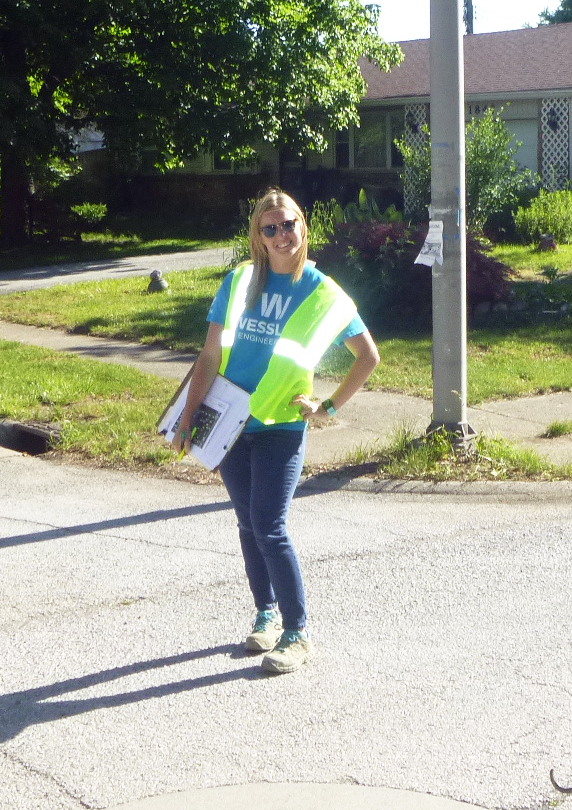EEE Alumni Spotlight
Bridget Philpott

Since graduating in 2016 with her BS in Environmental and Ecological Engineering (EEE), Bridget Philpott has been working at Wessler Engineering, an environmental engineering consulting firm in Indianapolis. At Wessler she works in the Wastewater Group as a Project Engineer primarily on the design of wastewater treatment plants (WWTP), lift stations, and force mains. Philpott also writes preliminary engineering reports, helps their clients apply for permits, and aides in the optimization of existing WWTP.
Philpott has been a member of the Indiana Water Environmental Association’s (IWEA) Residuals and Resource Recovery (R&RR) Committee for the last three years and served as the committee’s secretary this last year. Through that committee she has had the opportunity to present at the IWEA Annual Conference and at a few of the committee’s Lunch and Learns. Last December she was invited by the Danish Water Technology Alliance to spend a week in Denmark learning about their environmental policies and how their WWTP produces more energy than they require to run. Philpott has also completed two Biowin process modeling training courses.
The EEE program at Purdue encouraged Philpott to take a wide variety of classes that have helped her become a well-rounded environmental engineer. Having courses in not only wastewater treatment and urban hydraulics, but also ecology and water chemistry has allowed her to better understand the biological components of wastewater treatment process and the impact of pollutants on receiving streams. She has also been able to incorporate the systems thinking approach that is taught in the EEE program into her design projects.
“Take a wide variety of classes, especially during your sophomore and junior year,” Philpott advises current students. “This, along with internships and research, will give you the most exposure to the different career paths that are out there. Then senior year you can start to focus your classes on the sector of environmental engineering that you would most like to get a job in after graduation. There are so many different career options for EEE students, some traditional, some non-traditional, the more you look the more opportunities you will find!”
Kate Hughes

Kate Hughes graduated with her BSEEE in 2016 and then her MSEEE in 2017. Since then she also been working at Wessler Engineering in Indianapolis. Hughes works in the wastewater department where she is responsible for preparing preliminary engineering reports (PERs), hydraulics and hydrology design, practices and standards, preparation of plans, and working with clients on day to day basis. She also supports their Environmental Services department where she develops SPCC (Spill Prevention, Control, and Countermeasure) Plans, SWPPPs (Stormwater Pollution Prevention Plan), generates Environmental Assessment Reviews for PERs, and conducts local limit evaluations.
In addition to presenting and publishing a webinar for Wessler on alternative sewer rehabilitation methods, Hughes has also been active outside of her position at Wessler. She presented at the Indiana Water Environment Association (IWEA) conference and at the National Water Environment Foundation (WEF) conference. Continuing to learn and expand her training has been important to Hughes in furthering her career as a Professional Engineer. She has earned her PACP, MACP, and LACP (Pipeline/Manhole/Lateral Assessment Certification Program) Certifications and is also Confined Space (29 CFR 1910.146) trained and certified. Most recently, she is training to be a Certified Professional in Erosion and Sediment Control.
Hughes attributes the education in both the undergraduate and graduate level Engineering programs with providing her the core engineering skills and process thinking that is at the heart of her work. Along with the academic preparation to pass the Fundamentals of Engineering (FE) exam, the EEE program’s flexibility with electives enabled her to focus on soil quality and health, which inspired her and aided in her qualifying for the CPESC certification. Hughes highly suggests students consider taking the FE before or very soon after graduating. “In doing so, you will likely have a more flexible time schedule to prepare for the FE,” she says, “and your preparation will be bolstered by recently completing the rigorous engineering curriculum.” She also suggests applying for jobs in a variety of industries. “Whether you are certain about your future goals or if your career path is less clear,” Hughes says, “applying to a variety of industries not only assists in finding where your passion lies, but also creates more choices for your future.”
